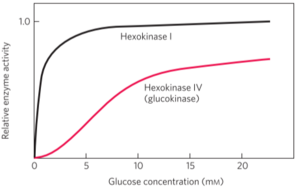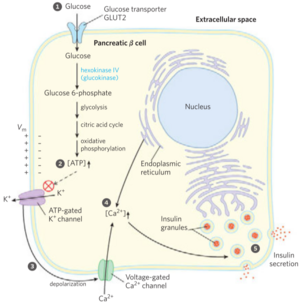Hexokinase and glucokinase
Hexokinase is an enzyme which catalyzes the phosphorylation of glucose into glucose 6-phosphate. There are multiple forms, from I to IV. Hexokinase IV is also called glucokinase.
Glucokinase (hexokinase IV) differs from the other three types of hexokinase (hexokinase I, II and III) in multiple ways. They’re summarized in the table below.
| Property | Hexokinase (I, II, III) | Glucokinase (hexokinase IV) |
|---|---|---|
| Concentration of glucose where enzyme is half-saturated (KM) | 1 mM | 10 mM |
| Inhibited by product (glucose 6-phosphate)? | Yes, strongly | No |
| Inhibited by fructose 6-phosphate? | No | Yes |
| Activated by glucose? | Yes | Yes |
| Location | All tissues | Beta cells and hepatocytes |
| Regulated by binding to an inhibitory protein? | No | Yes |
While hexokinase is regulated allosterically, glucokinase is regulated by a special protein that binds to glucokinase and transports it into the nucleus. Fructose 6-phosphate activates this process, thereby inhibiting glucokinase, while glucose makes the binding protein transport glucokinase back into the cytosol, so it can work.
Role in liver
In the liver we can find both glucokinase and GLUT2. GLUT2 is only activated when blood glucose is higher than normal, but when it is activated it is very efficient, so it quickly takes in glucose until the glucose concentrations in the cytosol and blood are equal. Because of this will the activity of glucokinase be directly affected by the glucose concentration in the blood. After a meal blood glucose will rise, glucose will be transported into the hepatocyte by the GLUT2.

Inside the hepatocyte will glucokinase rapidly convert glucose into glucose 6-phosphate. If hexokinase would be present instead of glucokinase would the reaction stop very quickly as glucose 6-phosphate accumulates in the cell. However, glucokinase is not inhibited by its product.
Glucokinase is also saturated at a much higher glucose concentration than hexokinase, so it’s able to keep up with the large amount of glucose, whereas hexokinase would be overwhelmed.
When between meals, blood glucose drops, and the liver does not want to use any of the scarce glucose in the blood, but instead leave it for other organs. Because glucokinase has a high KM it will not be active when blood glucose is low, so the liver doesn’t use up the glucose.
The liver will begin gluconeogenesis to replentish blood glucose, and fructose 6-phosphate, an intermediate in the gluconeogenesis, will inhibit glucokinase, so that glucose produced by the hepatocyte isn’t turned back into glucose 6-phosphate but instead can leave the cell into the blood.
Role in beta cells

After a meal will the beta cells start producing insulin. The mechanism of insulin release is detailed elsewhere. The increased blood glucose activates the GLUT2 transporter, which will transport glucose into the cell until the concentration inside the cell is equal to the blood glucose concentration.
The insulin release is stimulated by increased ATP levels in the cell, which is the result of glycolysis and oxidative phosphorylation of glucose. Because glucokinase is not inhibited by its product will the level of ATP in the cell be proportional to the level of glucose in the blood, meaning that GLUT2 and glucokinase work together as “glucose sensors”.
After insulin has been released, blood glucose will drop, so less glucose will flow into the beta cell so less ATP will be produced, which slows insulin secretion.
